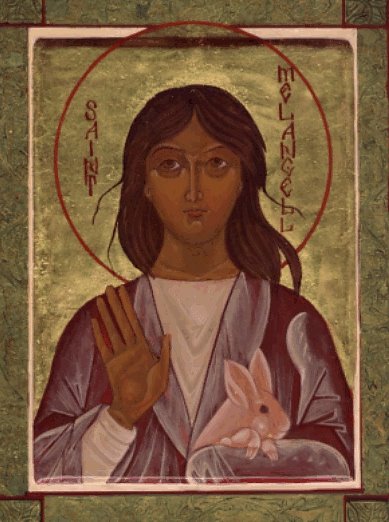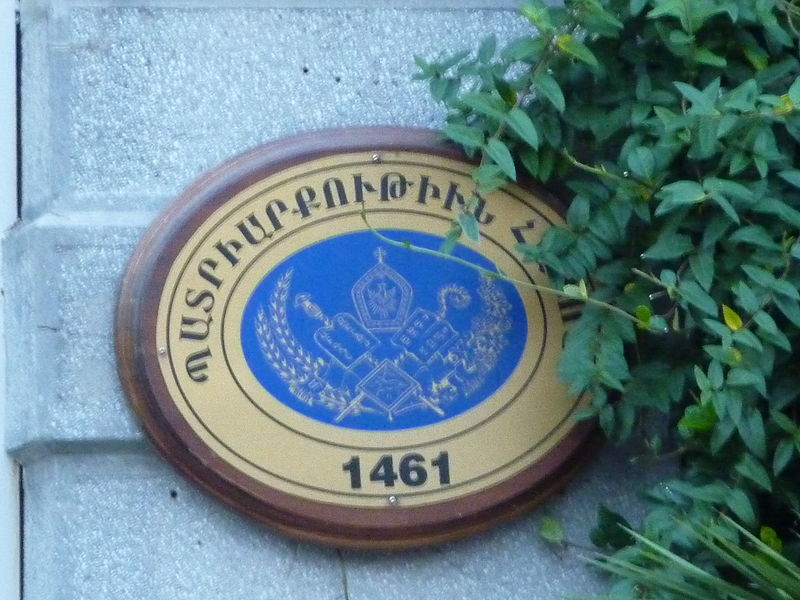 A typical brick-and-tile house in an older (1960s) suburb. Note the mature trees in the front yard.
A typical brick-and-tile house in an older (1960s) suburb. Note the mature trees in the front yard.
When you live for a long enough time in North America or in Australia, the way houses are built in a given region seems entirely natural. But when you move between the two, you do notice the difference. So here's an attempt of comparison typical middle-class (well, maybe lower-middle-class) homes in US (particularly, the Midwest) and Australia (particularly, South Asutralia, which is dry but not tropical or subtropical). The illustrations are
here.
 Front yard (the living room side), driveway, and car port. Not an inch of wood or vinyl siding in view. The TV antenna on the roof is pretty important for TV owners, as American style cable television is uncommon. The TV signal is free, and comes from the air.
Front yard (the living room side), driveway, and car port. Not an inch of wood or vinyl siding in view. The TV antenna on the roof is pretty important for TV owners, as American style cable television is uncommon. The TV signal is free, and comes from the air.
* Structure:
USA: a frame of two-by-fours, with plywood around it, and vinyl sidings on the sides. More expensive houses may have some brick - typically, just as a siding for the facade; others may have some bricks/cinderblacks as the lowest section of the wall. The roof may be covered with a variety of materials, often asphalt shingles.
Australia: a typical house here is "brick and tile", meaning the walls are build of solid brick all over, and the roof is cermaic tiles. On construction sites, I often see some kind of metal frame being built before brick is laid, but I don't know if every Australian brick house has such a frame inside.
This all means that the buildings age gracefully: the house I am in is said to have been built in the 1960s, but it looks almost new. An American 1960s house... well, it may look new, but it probably would have a couple changes of siding and roof shingles by now
* Floor plans: a variety of 1-story, split-level, and 2-story plans in the US. An Australia, a single-level floor plan (very similar to the US good old "ranch style house") still predominates. Basically, it's a big living room and kitchen in one end of the house; a long straight hallway with (usually) 3 bedrooms, a bath and a toilet (see below) in the other end.
While there are of course 2-storey houses in Australia, I can't recall seeing even a single one in my current suburb (Christie Downs), which is a fairly typical middle-class suburb of the 1960s
vintage. Typically, a 2-storey house is a luxury house in a wealthy neighborhood - on the seafront, or maybe on a very large lot in a more rural setting.
* Storage: While there are plenty of closets in most American homes, they are much less common in Australia. This 3-bedroom house only have one, fairly small, closet - in the largest bedroom. Certainly no closets of the walk-in variety. What, you have more things to store? You can always buy a "wardrobe": a large cabinet for storing clothes.
Of course, many homes here have various types of sheds in their backyards, built, naturally, out of corrugated iron.
* A garage in every modern house in the US; often just a car port (a parking area covered with a corrugated iron roof) in Australia.
* Heating: In the US, you'd often have a whole-house central heating system. Here in Australia, it is "central" heating in the sense that there is a gas furnace in the center of the house with a fan that blows hot air into the hallway. This is very good for warming up the hallway, not so much for the rest of the house :-)
* Water heating: similar system, but in Australia the hot water tank usually sists right *outside* of the house. (Hey, it's usually hot here!)
* Laundry:
USA: a washing machine connected to the water and sewer pipelines in some "industrial" way, meaning, it's probably has been done by a plumber). A clothes drier next to it.
Australia: a washing machine usually comparable to (simpler) American models, but the water/sewer connection is more often in a "do it yourself" way. There is a laundry sink next to the washing machine, and the cold and hot water hoses connect to the respective faucets. Many people make a point to make sure to actually close the faucets after using the machine, just in case. The machine's water draining pipe goes into the sink, and in the summer we attach an extension pipe to it so that the dirty water flows to the lawn.
In Australia, electric clothes driers are rather uncommon (I've only seen them in the houses of people who actually needed them for their business, e.g. those who'd run a hairdresser salon etc). But every house has a traditional Australian "umbrella" style clothes drying rack in the backyard (see photo).
* Stove:
US: electric, or self-starting gas range.
Australia: Got matches? (Or a cigarette lighter, at least...)
* Bathrooms. I like the American concept of a "combined" bathroom - a room that has both the toilet and the bathtub in it. Australians, however, more often go for the European concept of two separate rooms - a bathroom proper (just the bath and/or shower and a sink), and a toilet (a room with, well, just the toilet, and not even a sink). I find this arrangement rather inconvenient - why do you need so many doors and walls? - but I guess the point is that an American house may have 2 or 1.5 bathrooms, while a typical Australian house probably would have just 1 bath and 1 toilet.
* Shutters: rather bizarre immobile "fake shutters" nailed to the walls outside of the windows of many American houses. Very much operational roll-down-shutters on at least some of the windows of
Australian homes; usually they can be controlled from indoors (pulled up or down by an electric motor controlled by a button inside the house; or there is simply a handle you rotate). People
like them for privacy, security, and temperature control.

* Fencing:
US: a variety of choices, from tall wooden fences to chain link to none at all in some subdivisions.
Australia: people here definitely favor tall corrugated iron fences.
 Front yard (the bedrooms' side). The "tower" on top is the top of the evaporative cooling system.
Front yard (the bedrooms' side). The "tower" on top is the top of the evaporative cooling system.
* Air-conditioning is essential in much of the US; the users are supposed to keep one's windows closed. In Australia (at least, the drier parts, such as SA), they typically would have "evoparative cooling": a system that works pretty well in dry heat, and actually requires that one keeps one's windows slightly *open* when using it.
 Back yard, with the covered and sheltered "patio", and the iconic Australian umbrella-shaped laundry-drying rack. The white rabbit is optional. The roof "tower" is for the evaporative cooling system.
Back yard, with the covered and sheltered "patio", and the iconic Australian umbrella-shaped laundry-drying rack. The white rabbit is optional. The roof "tower" is for the evaporative cooling system.
* A variety of patio and deck styles can be used, optionally, in the US. A quintessential Australian feature is a paved area adjacent to the back of the house that is covered on top (with a corrugated-iron roof) and sides (with [theoretically, removable] strong transparent plastic) to create a space for outdoor entertainment recreation (barbecue), dining, smoking, whatever, throughout most of the year. The area is about size of the living room. Incidentally, this is a very convenient area to keep houseplants and seedlings: both those that need more shade (in the hot part of the year) and those that need somewhat of a "greenhouse" environment (during the colder part of the year). Some people, of course, also store a lot of junk there.
 The rainwater tank. This one is tiny - 800 L (200 gallons) or so, but many houses have tanks 10 times size of this, or more. An air-conditioner unit is seen on the left, but it is hardly ever used, since the evaporative cooling is usually sufficient even on the hottest days. The fence (on the right) is, of course, corrugated iron
The rainwater tank. This one is tiny - 800 L (200 gallons) or so, but many houses have tanks 10 times size of this, or more. An air-conditioner unit is seen on the left, but it is hardly ever used, since the evaporative cooling is usually sufficient even on the hottest days. The fence (on the right) is, of course, corrugated iron
* Water: in Australian cities and more densely suburban areas houses, of course, do have city water supply, but even then practically every house would have a rainwater tank: from a tiny one, as we have (just 800 liters = 200 gallons), to a large system with several tens of cubic meters. In more outer suburban or rural areas, there is often no city water mains (and no water bills, either!), but you're expected to live off the rainwater tank and maybe a "bore" (a drilled well). So in areas like this, you'd better budget your water... if you don't, you'd have to buy some from a tanker truck, which is of course rather expensive.
* Landscaping: in Australia, something is in bloom any time of year. And, of course, the palms...
 This is my review of"Nanjing's Ming and Qing Architecture" (''Nanjing Ming-Qing Jianzhu'', NJMQJZ) by Yang Xinhua, Lu Haiming et al. An earlier version of the review, without hyperlinks (I don't know how to insert them there), is on Google Books.
This is my review of"Nanjing's Ming and Qing Architecture" (''Nanjing Ming-Qing Jianzhu'', NJMQJZ) by Yang Xinhua, Lu Haiming et al. An earlier version of the review, without hyperlinks (I don't know how to insert them there), is on Google Books. 






































